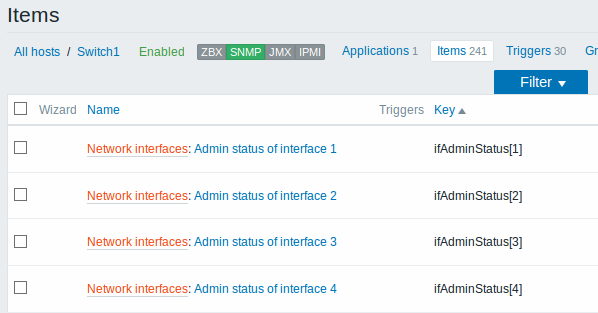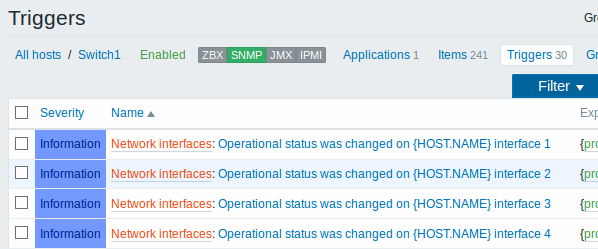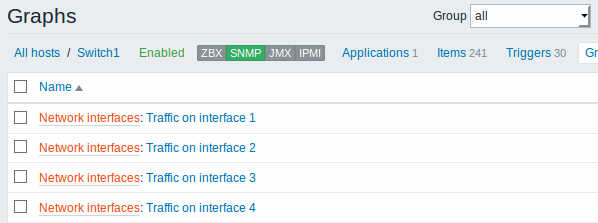3 Discovery of SNMP OIDs
Overview
In this section we will perform an SNMP discovery on a switch.
Item key
Unlike with file system and network interface discovery, the item does not necessarily has to have an "snmp.discovery" key - item type of SNMP agent is sufficient.
Discovery of SNMP OIDs is supported since Zabbix server/proxy 2.0.
To configure the discovery rule, do the following:
- Go to: Configuration → Templates
- Click on Discovery in the row of an appropriate template

- Click on Create discovery rule in the upper right corner of the screen
- Fill in the discovery rule form with the required details as in the screenshot below
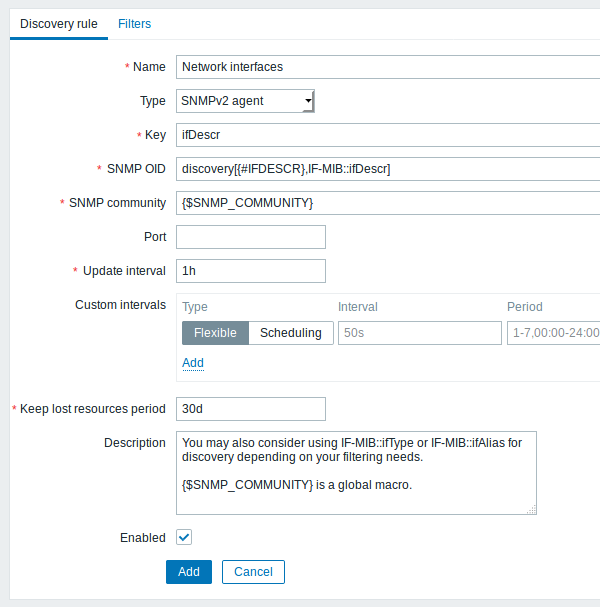
All mandatory input fields are marked with a red asterisk.
The OIDs to discover are defined in SNMP OID field in the following format: discovery[{#MACRO1}, oid1, {#MACRO2}, oid2, …,]
where {#MACRO1}, {#MACRO2} … are valid lld macro names and oid1, oid2... are OIDs capable of generating meaningful values for these macros. A built-in macro {#SNMPINDEX} containing index of the discovered OID is applied to discovered entities. The discovered entities are grouped by {#SNMPINDEX} macro value.
To understand what we mean, let us perform few snmpwalks on our switch:
$ snmpwalk -v 2c -c public 192.168.1.1 IF-MIB::ifDescr
IF-MIB::ifDescr.1 = STRING: WAN
IF-MIB::ifDescr.2 = STRING: LAN1
IF-MIB::ifDescr.3 = STRING: LAN2
$ snmpwalk -v 2c -c public 192.168.1.1 IF-MIB::ifPhysAddress
IF-MIB::ifPhysAddress.1 = STRING: 8:0:27:90:7a:75
IF-MIB::ifPhysAddress.2 = STRING: 8:0:27:90:7a:76
IF-MIB::ifPhysAddress.3 = STRING: 8:0:27:2b:af:9eAnd set SNMP OID to: discovery[{#IFDESCR}, ifDescr, {#IFPHYSADDRESS}, ifPhysAddress]
Now this rule will discover entities with {#IFDESCR} macros set to WAN, LAN1 and LAN2, {#IFPHYSADDRESS} macros set to 8:0:27:90:7a:75, 8:0:27:90:7a:76, and 8:0:27:2b:af:9e, {#SNMPINDEX} macros set to the discovered OIDs indexes 1, 2 and 3:
{
"data": [
{
"{#SNMPINDEX}": "1",
"{#IFDESCR}": "WAN",
"{#IFPHYSADDRESS}": "8:0:27:90:7a:75"
},
{
"{#SNMPINDEX}": "2",
"{#IFDESCR}": "LAN1",
"{#IFPHYSADDRESS}": "8:0:27:90:7a:76"
},
{
"{#SNMPINDEX}": "3",
"{#IFDESCR}": "LAN2",
"{#IFPHYSADDRESS}": "8:0:27:2b:af:9e"
}
]
}If an entity does not have the specified OID, then the corresponding macro will be omitted for this entity. For example if we have the following data:
ifDescr.1 "Interface #1"
ifDescr.2 "Interface #2"
ifDescr.4 "Interface #4"
ifAlias.1 "eth0"
ifAlias.2 "eth1"
ifAlias.3 "eth2"
ifAlias.5 "eth4"Then in this case SNMP discovery discovery[{#IFDESCR}, ifDescr, {#IFALIAS}, ifAlias] will return the following structure:
{
"data": [
{
"{#SNMPINDEX}": 1,
"{#IFDESCR}": "Interface #1",
"{#IFALIAS}": "eth0"
},
{
"{#SNMPINDEX}": 2,
"{#IFDESCR}": "Interface #2",
"{#IFALIAS}": "eth1"
},
{
"{#SNMPINDEX}": 3,
"{#IFALIAS}": "eth2"
},
{
"{#SNMPINDEX}": 4,
"{#IFDESCR}": "Interface #4"
},
{
"{#SNMPINDEX}": 5,
"{#IFALIAS}": "eth4"
}
]
} Item prototypes
The following screenshot illustrates how we can use these macros in item prototypes:
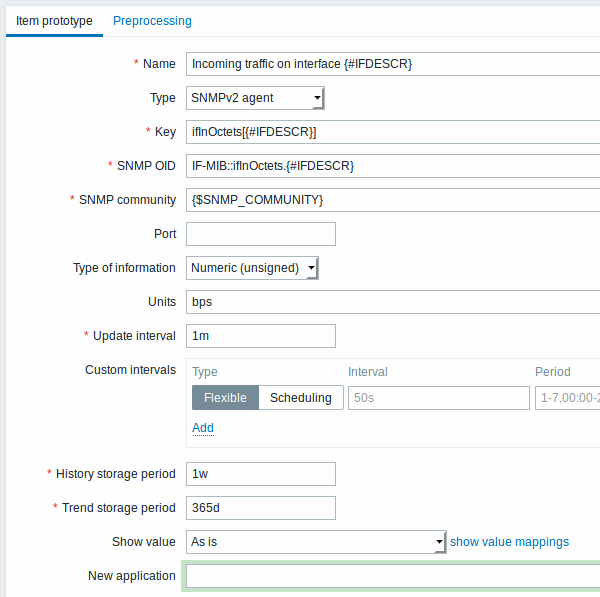
Again, creating as many item prototypes as needed:
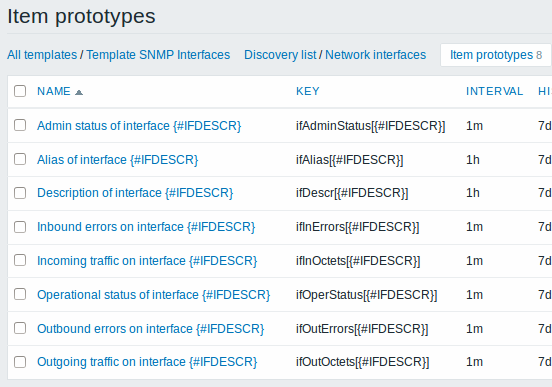
Trigger prototypes
The following screenshot illustrates how we can use these macros in trigger prototypes:
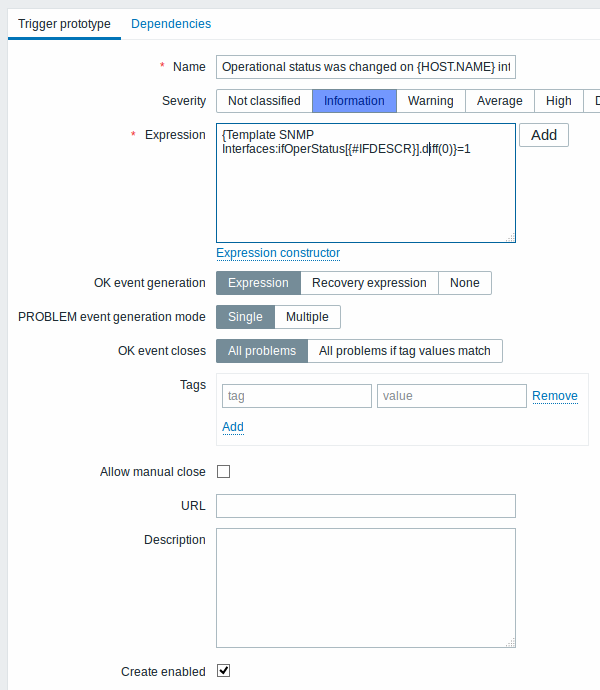

Graph prototypes
The following screenshot illustrates how we can use these macros in graph prototypes:
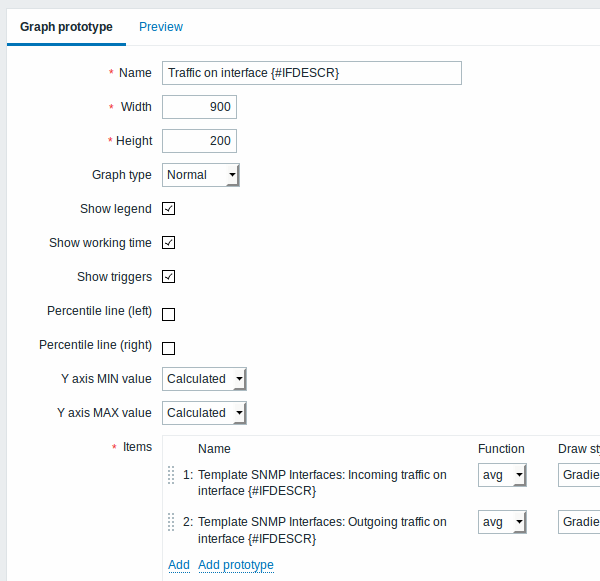

A summary of our discovery rule:

Discovered entities
When server runs, it will create real items, triggers and graphs based on the values the SNMP discovery rule returns. In the host configuration they are prefixed with an orange link to a discovery rule they come from.
